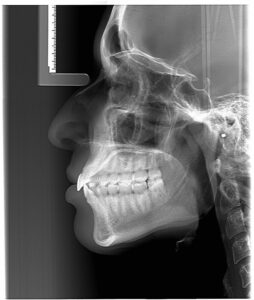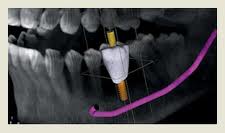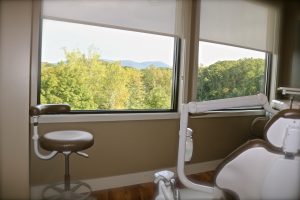Header logo
header top contact widget
Implant Placement
As You Age, Avoid A ‘Melting’ Face With Dental Implants
Posted on Feb 26, 2024 by William J. Claiborne, DDS MS
It seems the older one gets, the more conscious he or she is to the need for good health practices. While periodic exams and check-ups are part of this, eating healthy and getting ample exercise are practical ways to support a healthy body.
The same principles apply to oral health. While annual physical exams are needed, regular check ups and dental hygiene cleanings are as well. Through decades of research, “bad” bacteria in the mouth can lead to inflammatory reactions that can offset or worsen a number of health problems far beyond the mouth.
For now, let’s focus on your gum health and the presence of teeth. While natural teeth are the ideal structure for biting, chewing and speaking, the rigors of age – the natural wear and tear – can take its toll on teeth. Decay, gum disease, accidents and certain illnesses can lead to losing a tooth or teeth over the span of a lifetime.
There are several ways to replace a missing tooth (or teeth). A crown-&-bridge is a longstanding method to replace one or several teeth in one area. Or, a partial denture can replace a “scattering” of teeth in the same arch. However, the downside of these oral prosthetics is what’s beneath the gum line.
Your natural teeth are supported by your upper and lower jaw bone, known respectfully as the maxilla and mandible. With these strong, study bones, tooth roots are held securely. Thus, biting and chewing occurs comfortably.
The jaw bones are actually kept healthy by the presence of tooth roots. These roots provide stimulation to the bone as well as nourishment that feeds through the tooth’s interior.
When a tooth is removed, so is the stimulation and nourishment to that area of the jaw bone. Without it, the bone begins to shrink. As it declines in height, the adjacent teeth are more vulnerable to loss. Statistics show that teeth adjacent to areas where natural teeth are missing will be the most likely to be lost next.
This has a domino effect. Partials can replace the presence of teeth above the gum line, but there is nothing to benefit the jaw bones below. Thus, tooth loss continues and can go from a few missing teeth to losing all teeth (being “edentulous”).
According to the Center for Disease Control & Prevention (CDC), 69 percent of adults between the ages of 35 – 44 have lost at least one permanent tooth. By age 50, Americans are missing an average of 12 teeth. For adults between the ages of 65 – 74, 26 percent are missing all of their natural teeth. That’s over one-fourth of the adult population over age 65.
Although dentures and partials mimic the presence of teeth, the jaw bones below are shrinking away, and at a rather rapid pace. The pressure of wearing a denture or partial actually speeds this process up, known as “resorption.”
As these bones decline in mass, deep wrinkles form around the mouth. The corners of the mouth turn downward. The chin takes on a more pointed form and the mouth sinks into the face. The nose seems to get closer to the chin as the jaw bones thin. Jowls form as facial muscles detach from shrinking bone structure.
Changes in facial appearance also take place when bone structures shrink. For example, as the jaw bone thins, deep wrinkles form around the mouth. The corners of the mouth will start to turn down, even in a smile. Jowls form on each side of the face as facial muscles detach from the shrinking bone structure.
As the jaw bone declines further, the chin becomes more pointed and the nose seems to get closer to it. This leads to a collapsed mouth that is known as a “granny look.” This look ages the appearance of an individual far beyond their actual years.
Not to be overlooked is the ability to comfortably bite and chew food. This is essential for the digestive process, since the first stage of digestion begins in the mouth. When adults struggle to eat with a denture or partial, the efficiency of this initial stage of digestion is compromised.
It’s not unusual for adults who have “rocky” or “slippery” dentures to opt for soft foods that dissolve easily in the mouth. These are often carb heavy and lack the nutritional value of a diet that combines healthy proteins, fruits and vegetables.
However, missing teeth or dentures that move when eating can cause other detrimental problems. When people sense their dentures may cause embarrassment when eating, speaking or laughing with others, social involvement can take a hit. According to a 2012 statement by the World Health Organization:
“Oral health is essential to general health and quality of life. It is a state of being free from mouth and facial pain, oral and throat cancer, oral infection and sores, periodontal (gum) disease, tooth decay, tooth loss, and other diseases and disorders that limit an individual’s capacity in biting, chewing, smiling, speaking, and psycho-social well-being.”
As an Asheville periodontist, my dental specialty includes the diagnosis and placement of dental implants. Dental implants are the closest thing to natural teeth.
Dental implants were designed to recreate the presence of natural teeth both above and below the gum line. Because teeth attached to the implants are supported by the jaw bone, the study foundation restores the ability to bite and chew without movement or fear of embarrassing slips.
For patients who are missing a great deal of bone, we offer bone rebuilding that does not require a bone graft. We also perform sinus lifts (when the upper jaw has declined to a significant level) to restore sufficient bone distance between vital structures.
For many of our dental implant patients, their lives become more active with the restored confidence. They become more socially involved, have more self-confidence and higher self-esteem. And the advantages of dental implants over other tooth replacement options are numerous.
• Dental implants are designed to last your lifetime. They do not decay, need root canals or compromise neighboring teeth or bone structure.
• Because dental implants are positioned in the jaw, they recreate stimulation to the bone. This helps to preserve the bone’s mass, halting the pace of jaw bone shrinkage (known as resorption).
• Resorption is what causes changes in one’s facial appearance, aging one’s appearance far older than their actual age.
• Dental implants do not move or slip when eating, speaking or laughing. A denture is designed to fit the contours of one’s gum ridge; contours that exist at the time the denture is made. However, as resorption reduces bone height, the ridge that holds the denture flattens out over time. This is why a denture becomes ‘wobbly’ or ‘slippery.’
• Dental implant treatment is largely determined by the number of implants placed. In most cases, one implant can support more than one tooth. A full arch (all upper or lower) of teeth are typically supported by several strategically-placed implants.
• Unlike a crown-&-bridge, dental implants so not need the support of adjacent teeth. Therefore, it is not necessary to have teeth shaved down for crowning simply to serve as supports for a bridge.
In our Asheville periodontal dental office, we have highly-advanced technology that aids in the diagnosis and placement process of dental implants. These features help to enhance patient comfort, shorten treatment time, and provide optimal results. Advanced technology includes:
– Computerized Dental Implant Placement – an advanced system for pre-surgical positioning of dental implants using a 3D model of the patient’s jaw. Once the implant type is selected, a template is developed for optimal treatment success.
– Cone Beam Imaging – is ideal for diagnoses and treatment planning through images that provide a clear view of the upper and lower jaw (including nerve canals), with rotations that show sagittal, axial, and coronal planes in a process that is quick, painless and at minimal radiation levels.
– Dental Laser – This small, hand-held device is a tremendous asset when it comes to both the health and appearance of gum tissues. Not only does the laser eliminate or greatly minimize bleeding during procedures, it reduces numbing requirements, removes bacteria and easily uncovers gum tissue where dental implants have been placed. Additionally, laser dentistry can beautifully re-contour or repair gum tissue with a precision line.
As a periodontal specialist serving Western NC, I take great pride in the diagnosis and placement of dental implants with each selected based upon the patient’s individual needs and goals. We provide oral or I.V. sedation to ensure a comfortable experience and a friendly, respectful environment.
To schedule an examination appointment or to begin with a consultation, call 828-274-9440. A referral is not always necessary.
Gum Disease, Tooth Loss Warnings For Smokers
Posted on Jan 29, 2024 by William J. Claiborne, DDS MS
We’re a month in to the new year. If you made the resolution to quit smoking, you may be struggling at this point. But keep up the effort. In addition to the many problems associated with smoking, your smile is also at risk.
As a periodontist in Asheville, NC, I’ve seen how significantly the habit of cigarette smoking can have on one’s smile. It’s no secret that smoking cigarettes can stain teeth and cause bad breath. However, nicotine in any form is a hazardous force in the mouth.
In studies, smokers were 3 – 6 times more likely to have gum disease than nonsmokers. One reason is because smoking is very drying to oral tissues and decreases saliva production. Less saliva means there is less of a natural ‘rinsing’ away of bacteria in the mouth. This leads to higher concentrations of oral bacteria.
Dry tissues also slows healing in the mouth. The longer it takes for tissues to heal, the greater the potential for bacterial complications.
In one study, it was found that smokers were twice as likely as non-smokers to lose teeth in the five years after completing treatment for gum disease. Smokers are also shown to respond less favorably to oral surgery treatments due to slowed healing. For the same reason, dental implants are more likely to fail in smokers.
Researchers who have studied the effects of tobacco smoke on oral tissues say it appears to interfere with the body’s natural ability to fight disease and promote healing. Apparently, smoking affects the way gum tissue responds to all types of treatment, possibly due to tobacco chemicals that interfere with blood flow to the gums. This slows the healing process and makes treatment results less favorable.
According to a study at Temple University, pipe and cigar smokers and users of smokeless tobacco (“chew”) are just as prone to implant complications than cigarette smokers. The study showed three times the amount of moderate to severe gum disease as that of non-smokers.
The American Dental Association (ADA) also warns that smoking can cause the gums to recede from teeth, exposing vulnerable tooth root sections. This enables easier entry of oral bacteria into the structures that support tooth roots. Smoking can also delay healing following periodontal therapy, extractions or implant placement. The longer it takes oral tissues to heal, the greater the risks for infection to develop.
Additionally, smoking increases the risks of oral cancer, lesions inside the mouth, periodontal (gum) disease, enamel erosion and tooth loss. It greatly reduces saliva flow in the mouth, which is a tremendous aid in removing bacteria and food particles from the mouth, helping to control bacteria levels. The condition of “dry mouth” also causes bad breath.
According to the Centers for Disease Control & Prevention (CDC), a smoker has twice the risk for gum disease compared with that of a nonsmoker. (https://www.cdc.gov/tobacco/campaign/tips/diseases/periodontal-gum-disease.html)
When a patient is diagnosed with advanced periodontal disease (periodontitis), they must make a commitment of time and expense to rid this inflammatory disease from their mouths. For those who ignore its presence or assume it will get better on its own, the disease will simply progress further.
Gum disease begins with sore gums that may bleed while brushing teeth. Or, it may cause no noticeable symptoms at all in early stages.
As it worsens, gum disease will cause frequent bad breath, tender gums that turn red, gum recession, and gums that bleed easily when brushing. Pus pockets may form on the gums. As it attacks the structures beneath the gum line, teeth may loosen or shift.
As the nation’s leading cause of adult tooth loss, it brings the hard decisions (and expense) for replacement. After all, you need teeth for eating and speaking. Do you go with dental implants? Or, do you take on the challenges that come with dentures and partials? As hard as the decisions of replacing teeth can be, gum disease can bring even more devastation with it.
Research has linked the bacteria of gum disease to serious health problems. These include heart disease, stroke, preterm babies, arthritis, diabetes, impotency, some cancers and even Alzheimer’s disease. These connections occur through the infectious bacteria of gum disease entering the bloodstream through tears in diseased gum tissues.According to the Centers for Disease Control & Prevention (CDC), a smoker has twice the risk for gum disease compared with that of a nonsmoker.
(https://www.cdc.gov/tobacco/campaign/tips/diseases/periodontal-gum-disease.html)
When a patient is diagnosed with advanced periodontal disease (periodontitis), they must make a commitment of time and expense to rid this inflammatory disease from their mouths. For those who ignore its presence or assume it will get better on its own, the disease will simply progress further.
Gum disease begins with sore gums that may bleed while brushing teeth. Or, it may cause no noticeable symptoms at all in early stages.
As it worsens, gum disease will cause frequent bad breath, tender gums that turn red, gum recession, and gums that bleed easily when brushing. Pus pockets may form on the gums. As it attacks the structures beneath the gum line, teeth may loosen or shift.
As the nation’s leading cause of adult tooth loss, it brings the hard decisions (and expense) for replacement. After all, you need teeth for eating and speaking. Do you go with dental implants? Or, do you take on the challenges that come with dentures and partials? As hard as the decisions of replacing teeth can be, gum disease can bring even more devastation with it.
Research has linked the bacteria of gum disease to serious health problems. These include heart disease, stroke, preterm babies, arthritis, diabetes, impotency, some cancers and even Alzheimer’s disease. These connections occur through the infectious bacteria of gum disease entering the bloodstream through tears in diseased gum tissues.
If you feel your smile is safe by switching to vaping (use of e-cigarettes), read on.
Because of the vape’s moist presence in the mouth, the assumption with vaping over smoking cigarettes is the “benefit” of oral dryness. However, this is easily dispelled when looking at the true facts.

While there are more than 7,000 chemicals found in the smoke of tobacco products, (including nicotine, tar, carbon monoxide, acetaldehyde and N-nitrosamines), nicotine is the primary addicting component. A study of some e-cigarette products found the vapor contains known carcinogens and toxic chemicals, as well as potentially toxic metal particles from the device itself.
The e-liquids delivered by these devices typically contain nicotine, propylene or polyethylene glycol, glycerin, and additives.
In addition to the treatment of all stages of periodontal disease, a periodontist is highly skilled in dental implant placement. Dental implants have become a leading choice in tooth replacement for many reasons, including:
• Dental implants restore one’s natural ability to bite and chew comfortably.
• Dental implants allow people to eat a healthy diet of foods, chewing thoroughly to support good digestion.
• Dental implants enhance confidence when speaking, laughing and dining in social gatherings.
• Dental implants recreate stimulation to the jaw bone like that of natural tooth roots, which helps to halt bone loss.
• Through the prevention of further bone loss, dental implants contribute to the well-big of neighboring teeth
• Dental implants slow the aging changes to facial appearance by preserving jaw bone mass.
• Dental implants, with properly maintenance, are designed to last a lifetime.
One of the most appealing aspects is the longevity of dental implants. Today’s implants are designed to last a lifetime with up to a 98 percent success rate. This is one of the highest success rates for any implant-in-bone procedure.
However, like anything that’s not a natural part of the body, there is a potential for failure. For smokers, the habit is a significant contributor to implant failure.
Studies have shown that people who smoke have more calculus (also known as tartar) than nonsmokers. Calculus is the cement-like buildup on teeth, which is a concentrated mass of oral bacteria. When gums are weakened by an over-accumulation of bacteria, successful integration of dental implants is compromised.
Having a successful outcome with dental implant treatment is worth the efforts to quit smoking. Within two weeks of quitting, gum health improves. (https://www.cancer.gov/about-cancer/causes-prevention/risk/tobacco/cessation-fact-sheet)
In our Western NC periodontal dental office, we intend for every dental implant we place to provide a successful outcome. However, patients who smoke must understand they have higher risks for complications, and even failure of dental implants. The first step is a thorough evaluation of your gums and the existing bone to support dental implants.
At your initial visit, I’ll answer your questions about the process, anticipated costs, and even sedation options. Call 586-739-2155 for an exam appointment or consultation or tap here to begin.
Dental Implants – Advantages of Specialized Skills, Advanced Technology, Optimal Comfort
Posted on Jan 10, 2024 by William J. Claiborne, DDS MS
It wasn’t that long ago when shopping for Christmas presents was quite the time-consuming ordeal. Today, we do searches for gift ideas online, check price comparisons, and have the items show up on our doorstep within a day or so.
Advancements through computerized technology have things running more efficiently and, in many cases, culminate into superior outcomes. This is true in dentistry, especially for those who opt for dental implants to replace missing teeth.
There are many reasons for people to choose dental implants, including:
– Designed to last a lifetime
– Look, feel and function like natural teeth
– Won’t decay or need repairs
– Restore chewing and biting comfort and stability
– Enhance overall health and confidence
– Halt the process of facial bone loss
Occasionally, dental implants are occasionally offered by general dentists. As a periodontist, however, I am referred most of our dental implant patients by other dentists and dental specialists. This is because a periodontist has advanced education and skills in the diagnosis and treatment of all areas of the tissues in the mouth (including the reshaping of gum tissues).
Periodontists are also specialists when it comes to the diagnosis and placement of dental implants. They are trained to understand the intricate concepts involved in selecting the proper type of implant based on each individual. These skills include the understanding of precision placements of implants at proper depths and angles. Additionally, periodontists are able to optimize your comfort and treatment outcome.
Still, another reason we are referred patients for dental implants because we can offer patients a wider variety of choices when it comes to implant systems.
There are many types of dental implants. Various systems are designed to support one replacement tooth (the “restoration”), a bridge of two or more teeth, or a full denture supported by several strategically-placed implants. Understanding the unique advantages of all systems enables us to choose the best type for the patient’s individual needs and goals.
For example, the All On Four dental implant system is designed to support non-removable teeth on just 4 implants (per arch). With its specially-designed implanted portions, these longer implants can fully distribute biting and chewing forces.
All-On-4 is an ideal choice for people who have lost bone mass due to lengthy periods of tooth loss. Because “All On 4” implants can be placed in minimal bone, many patients are able to avoid the need for bone rebuilding procedures prior to traditional implant placement.
In the placement, a periodontist is also the best “go-to” in dental implant skills. Here’s why…
For a dental implant to serve as a lasting tooth replacement system, it must be positioned in the jaw bone to specific depths and angles. An implant that is wrongly positioned can function less efficiently and lead to the need for removal.
For example, a periodontist can incorporate bone rebuilding procedures into treatment to a proper depth for patients missing a great deal of bone mass (typically due to missing natural teeth for many years). This can help to restore bone that has occurred in the mandible (lower jaw) or maxilla (upper jaw), which may also require a sinus lift.
Another example is a patient who has lost teeth due to periodontal (gum) disease. Because a periodontist combines advanced skills in treating gum disease as well as in dental implants, these patients have an added advantage when it comes to treatment success.
When it comes to the best way to pinpoint and tackle specific issues with our health, it makes sense to see a doctor who has received specialized training in that area. This helps to take the guesswork out of diagnosis and enhances the potential for a successful outcome in an efficient process.
A periodontist also has a reputation for being able to optimize patient comfort. Because a periodontal specialist is uniquely skilled in the care of gum tissues, he or she can provide a conservative approach to the placement process. Through respectful treatment of oral tissues (in both placement and exposure for restorations), less disruption to the gums allows for faster healing and higher comfort levels.
 In our Western NC periodontal dental office, we incorporate our care with the advantages of some of the most advanced technology in dentistry; many options which are not readily available in other dental offices in our region. These computerized images offer advantages to patients in helping to minimize treatment needs.
In our Western NC periodontal dental office, we incorporate our care with the advantages of some of the most advanced technology in dentistry; many options which are not readily available in other dental offices in our region. These computerized images offer advantages to patients in helping to minimize treatment needs.
These include:
- LANAP (Laser-Assisted New Attachment Procedure) with PerioLase MVP 7 – an advanced protocol that efficiently and effectively treats advanced gum disease with the added advantages of a dental laser. This offers a non-surgical alternative for patients with moderate to severe periodontal disease and has even been found to stimulate bone regrowth in damaged areas.
- Cone Beam Imaging – is ideal for diagnoses and treatment planning through images that provide a clear view of the upper and lower jaw (including nerve canals), with rotations that show sagittal, axial, and coronal planes in a process that is quick, painless and at minimal radiation levels.
- CareStream Cone Beam Computer Tomography Imaging – is enhanced tomography that works with 3D imaging for exceptional detail and range.
- CS 3600 Intraoral Scanner – quickly and comfortably captures digital impressions to create precision models or appliances accurately and easily (crowns, inlays, onlays, bridges, orthodontic appliances, aligners, custom abutments) without the need for bulky, goopy trays.
- Computerized Dental Implant Placement – an advanced system for pre-surgical positioning of dental implants using a 3D model of the patient’s jaw. Once the implant type is selected, a template is developed for optimal treatment success.
For optimal comfort, we offer several sedation options, including oral and IV sedation. Oral sedation is a pill that helps patients relax. It also has an amnesiac effect, leaving most with little or no memory of treatment afterward. I.V. sedation (also known as “twilight sleep”) places the patient in a deeper sleep state and erases memory of the procedure. It is administered by a doctor of anesthesiology for optimal comfort and safety.
In our Western NC periodontal dental office, anesthesia is overseen by a Medical Doctor (MD) who is a board certified Anesthesiologist. With both sedation options, patients are closely monitored with advanced safety equipment throughout treatment.
Our goal is to help people move forward with treatment affordably for enhanced appearance, self-confidence and sense of security.
For those who have bypassed dental implants because of cost, our payment plans are often able to help patients enjoy the benefits of their dental implants without straining their budget. Most of these payment plans require no down payment, are interest-free, and have no prepayment penalty.
If you’ve considered dental implants in the past but have held back because of obstacles that may actually be overcome, begin by calling our Asheville periodontal dental office and speaking to our friendly staff at: 828-274-9440. Many dental implant patients find they were able to achieve the healthy smile they desired once they consulted with us and learned the options based upon their individual needs.
What Gum Disease Bacteria Does To You That May Surprise You.
Posted on Dec 15, 2023 by William J. Claiborne, DDS MS
As we round the corner of another year, making oral hygiene a priority seems a distant thought in the midst of holiday preparations and activities of the season. But, it should be at all times in our lives, for many reasons.
Over the years, research has continuously shown that the bacteria of periodontal disease can have a number of harmful effects – in the mouth AND elsewhere.
This is because these inflammatory bacteria can enter the bloodstream and travel throughout the body. Studies show that these bacteria can activate or worsen a number of serious health problems.
People easily understand that a mouthful of bacteria can cause bad breath and gums that may be tender and redden in color. This makes sense, since an area with a skin cut can redden and swell if it doesn’t heal properly. Yet, because gum tissues are concealed behind cheeks and lips, it is easier to ignore problems that may be clear that something is wrong if more exposed.
To be clear, bacteria in our bodies is not always a bad thing. For example, certain bacteria in the gut actually enhance the process of digestion and help to keep the digestive system operating efficiently.
However, some bacteria are bad. These ignite when too much bacteria invade the body, causing the immune system to become overburdened. Bacterial overload can leave the body’s natural defense response, white blood cells, unable to conquer the infection. So, when a cut becomes infected, your doctor may prescribe an antibiotic to give the immune system added reinforcements.
And, when bacteria overload occurs in the mouth, an inflammatory reaction begins. This is the beginning of gum disease.
Signs of gum disease include bleeding or sore gums, persistent bad breath, receded gums, and/or gums that are red rather than a healthy pink. These are warning signs since gum disease will only worsen without treatment.
As gum disease progresses, gums begin to pull away from the base of teeth, gums become very tender and bleed easily when brushing, pus pockets form on gums and teeth may shift or loosen.
Unfortunately, gum disease is ignored too often by adults in the U.S. The CDC estimates that over 47% of Americans have some level of gum disease, which is also the leading cause of tooth loss.
A periodontist is a specialist in the treatment of all stages of gum disease and in the placement of dental implants. He or she is the expert who can help to restore a bacteria-burdened “oral cavity” to a healthy state.
In addition to a healthy smile, the health of your gums can impact your overall health. By keeping the bacteria of advanced gum disease, known as periodontitis, you lower your risks of a long list of serious health problems that have been shown connected to gum disease bacteria. These include:
• Heart Disease & Stroke – According to research, having advanced gum disease makes you twice as likely to develop heart disease. This is due to clot-causing proteins that occur from oral bacteria that can clog arteries, including the carotid artery that supplies the brain with blood.
• Dementia & Alzheimer’s disease – Studies have shown that tooth loss from oral bacteria is a risk factor for memory loss and early stage Alzheimer’s disease. Apparently, oral infection cause inflammation triggers that can lead to the destruction of brain cells.
• Cancer – Researchers found that males with gum disease are 54% more likely to develop pancreatic cancer, nearly 50% more likely to develop kidney cancer and 30% more likely to have blood cancers.
• Diabetes – Because people with diabetes are more susceptible to infections, with 95% of whom also have periodontal disease.
• Erectile Dysfunction – Men with periodontal disease are 7 times more likely to have erectile dysfunction (ED).
• Premature Birth – Nearly 13% of U.S. babies are born premature, which can lead to breathing issues and infections. Infection in the mother’s body, which includes infection from periodontal disease, can create inflammatory reactions that are related to premature and low birth weight babies.
• Infertility – Research has found that gum disease can complicate attempts for a female to become pregnant.
• Respiratory Problems – When bloodborne bacteria from gum disease reaches the lungs, people with respiratory problems are at higher risk of pneumonia and acute bronchitis (COPD).
It has been said that the mouth is the gateway to the body. Whether it’s the holidays or vacation time or just a busy schedule, your oral health should be a commitment. It takes just minutes a day to brush your teeth thoroughly (at least 2 minutes each time), twice daily, floss daily and swish after meals.
Drink plenty of water, especially after consuming caffeinated beverages or alcohol (including wine). If you smoke, begin with a periodontal exam and ask our hygienist for at-home care instructions.
Call 828-274-9440 if you have questions about your gums or if you are experiencing any of the above mentioned symptoms of gum disease. Also, visit our website to learn more about our sedation options (including “twilight sleep”) and advanced technology, which often reduces treatment time while enhancing comfort.
Recent Posts
Categories
Archives
- September 2024
- August 2024
- July 2024
- June 2024
- May 2024
- April 2024
- March 2024
- February 2024
- January 2024
- December 2023
- November 2023
- October 2023
- September 2023
- August 2023
- July 2023
- June 2023
- May 2023
- April 2023
- March 2023
- February 2023
- January 2023
- December 2022
- November 2022
- October 2022
- September 2022
- August 2022
- July 2022
- June 2022
- May 2022
- April 2022
- March 2022
- February 2022
- January 2022
- December 2021
- November 2021
- October 2021
- September 2021
- August 2021
- July 2021
- June 2021
- May 2021
- April 2021
- March 2021
- February 2021
- January 2021
- December 2020
- November 2020
- October 2020
- September 2020
- August 2020
- July 2020
- June 2020
- May 2020
- April 2020
- March 2020
- February 2020
- January 2020
- December 2019
- November 2019
- October 2019
- September 2019
- August 2019
- July 2019
- June 2019
- May 2019
- April 2019
- March 2019
- February 2019
- January 2019
- December 2018
- November 2018
- October 2018
- September 2018
- August 2018
- July 2018
- June 2018
- May 2018
- April 2018
- March 2018
- February 2018
- January 2018
- December 2017
- November 2017
- October 2017
- September 2017
- August 2017
- July 2017
- June 2017
- May 2017
- April 2017
- March 2017
- February 2017
- January 2017
- December 2016
- November 2016
- October 2016
- September 2016
- August 2016
- July 2016
- June 2016
- May 2016
- April 2016
- March 2016
- February 2016
- January 2016
- December 2015
- November 2015
- October 2015
- September 2015
- August 2015
- July 2015
- June 2015
- May 2015
- April 2015
- March 2015
- February 2015
- January 2015
- December 2014
- November 2014
- October 2014
- September 2014
- August 2014
- July 2014
- June 2014
- May 2014
- April 2014
- March 2014
- February 2014
- January 2014
- December 2013
- November 2013
- October 2013
- September 2013
- August 2013
- July 2013
- June 2013
- May 2013
- April 2013
- March 2013
- February 2013
- January 2013
- December 2012
- November 2012
- October 2012
- September 2012
- August 2012
- July 2012
- June 2012


